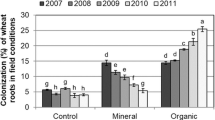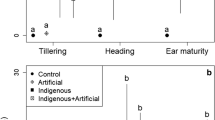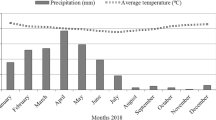Abstract
Mycotrophy of previous crops has been shown to have an impact on arbuscular mycorrhizal fungi (AMF), and the growth and productivity of succeeding crops. We studied the impact of 3 years of cultivation of eight crops with different degrees of mycotrophy, including mycorrhizal (strawberry, rye, timothy, onion, caraway) and non-mycorrhizal (turnip rape, buckwheat, fiddleneck) hosts, as well as the impact of peat amendment, on the effectiveness, amount and diversity of indigenous AMF. A field experiment having a split-plot design with peat amendment as the main plot, crop cultivation as a sub-plot and three replications, was carried out on silt clay mineral soil in 1999–2001. A well-humified dark peat was applied immediately before establishment of the field experiment. Each year, the relative mycorrhizal effectiveness of soil collected in September, in terms of shoot dry weight (RMEDW), was determined in a bioassay. In the 3rd year of the experiment, AMF spores were also extracted and identified from the field soil. Expressed as the mean of 3 years of cropping in unamended soil, the mycorrhizal crops strawberry and caraway maintained RMEDW most effectively, while the values were lower in the non-host crops buckwheat, turnip rape and fiddleneck. In addition, the numbers of AM spores detected in soil were considerably greater during 3 years of strawberry cultivation. In soil under caraway, there were high numbers of AM spores compared to the other crops. In soil amended with peat, the situation was in some cases opposite of that of unamended soil; RMEDW was highest in rye and onion and lowest in strawberry and caraway. The reasons behind the negative impact of peat on mycorrhizal effectiveness in strawberry soil may be due to the microbiological properties of peat. The importance of including mycotrophic species in crop rotations for maintaining high soil quality and for increasing yields of subsequent crops is discussed.





Similar content being viewed by others
References
Arihara J, Karasawa T (2000) Effect of previous crops on arbuscular mycorrhizal formation and growth of succeeding maize. Soil Sci Plant Nutr 46:43–51
Arpiainen V, Kyllönen H, Nissilä M (1986) Turpeen, puun, kuoren ja ligniinin flash-pyrolyysi. Osa 1. Tutkimusten nykytila ja arvio teollisista sovellusmahdollisuuksista. Espoo, Valtion teknillinen tutkimuskeskus, Tutkimuksia 455, pp 120
Augé RM (2000) Stomatal behaviour of arbuscular mycorrhizal plants. In: Kapulnik Y, Douds DD Jr (eds) Arbuscular mycorrhizas: physiology and function. Kluwer, Dordrecht, pp 201–237
Bagayoko M, Buerkert A, Lung G, Bationo A, Römheld V (2000) Cereal/legume rotation effects on cereal growth in Sudano-Sahelian West Africa: soil mineral nitrogen, mycorrhizae and nematodes. Plant Soil 218:103–116
Barea JM, Jeffries P (1995) Arbuscular mycorrhizas in sustainable soil-plant systems. In: Varma A, Hock B (eds) Mycorrhiza. Springer, Berlin Heidelberg New York, pp 521–560
Bever JD, Morton JB, Antonovics J, Schultz PA (1996) Host-dependent sporulation and species diversity of arbuscular mycorrhizal fungi in a mown grassland. J Ecol 84:71–82
Biermann B, Linderman RG (1983) Effect of container plant growth medium and fertilizer phosphorus on establishment and host growth response to vesicular-arbuscular mycorrhizae. J Am Soc Hortic Sci 108:962–971
Boddington CL, Dodd JC (2000) The effect of agricultural practices on the development of indigenous arbuscular mycorrhizal fungi: I. Field studies in an Indonesian ultisol. Plant Soil 218:137–144
Calvet C, Estaún V, Camprubi A (1992) Germination, early mycelial growth and infectivity of a vesicular-arbuscular mycorrhizal fungus in organic substrates. Symbiosis 14:405–411
Douds DD Jr, Millner PD (1999) Biodiversity of arbuscular mycorrhizal fungi in agroecosystems. Agric Ecosyst Environ 74:77–93
Douds DD Jr, Janke RR, Peters SE (1993) VAM fungus spore populations and colonisation of roots of maize and soybean under conventional and low-input sustainable agriculture. Agric Ecosyst Environ 43:323–335
Douds DD Jr, Galvez L, Franke-Snyder M, Reider C, Drinkwater LE (1997) Effect of compost addition and crop rotation point upon VAM fungi. Agric Ecosyst Environ 65:257–266
Ellis JR, Roder W, Mason SC (1992) Grain sorghum-soybean rotation and fertilization influence on vesicular-arbuscular mycorrhizal fungi. Soil Sci Soc Am J 56:783–794
Estaún V, Calvet C, Camprubi A (1994) Arbuscular mycorrhizae and growth enhancement of micropropagated Prunus rootstock in different soilless potting mixes. Agric Sci Finl 3:263–267
Galvez L, Douds DD, Drinkwater LE, Wagoner P (2001) Effect of tillage and farming system upon VAM fungus populations and mycorrhizas and nutrient uptake of maize. Plant Soil 228:299–308
Gavito ME, Miller MH (1998) Changes in mycorrhiza development in maize induced by crop management practices. Plant Soil 198:185–192
Gerdemann JW, Nicolson TH (1963) Spores of mycorrhizal Endogone species extracted from soil by wet sieving and decanting. Trans Br Mycol Soc 46:235–244
Goicoechea N, Antolín MC, Sánchez-Díaz M (1997) Influence of arbuscular mycorrhizae and Rhizobium on nutrient content and water relations in drought stressed alfalfa. Plant Soil 192:261–268
Gollotte A, Tuinen D van, Atkinson D (2004) Diversity of arbuscular mycorrhizal fungi colonising root of the grass species Agrostis capillaris and Lolium perenne in a field experiment. Mycorrhiza 14:111–117
Guillemin J-P, Gianinazzi V, Gianinazzi-Pearson V, Marchal J (1994) Contribution of arbuscular mycorrhizas to biological protection of micropropagated pineapple (Ananas comosus (L.) Merr) against Phytophthora connamomi Rands. Agric Sci Finl 3:241–252
Gumpertz ML, Brownie C (1993) Repeated measures in randomized block and split-plot experiments. Can J For Res 23: 625–639
Harinikumar KM, Bagyaraj D (1988) Effect of crop rotation on native vesicular-arbuscular mycorrhizae in soil. Plant Soil 110:77–80
Harrier LA, Watson CA (2003) The role of arbuscular mycorrhizal fungi in sustainable cropping systems. Adv Agron 20:185–225
Heijden MGA van der, Klironomos JN, Ursic M, Moutoglis P, Streitwolf-Engel R, Boller T, Wiemken A, Sanders IR (1998) Mycorrhizal fungal diversity determines plant biodiversity, ecosystem variability and productivity. Nature 396:69–72
Helgason T, Daniell TJ, Husband R, Fitter AH, Young JPW (1998) Ploughing up the wood-wide web? Nature 394:431
Hodge A (2003) Plant nitrogen capture from organic matter as affected by spatial distribution, interspecific competition and mycorrhizal colonization. New Phytol 157:303–314
Hodge A, Campbell CD, Fitter AH (2001) An arbuscular mycorrhizal fungus accelerates decomposition and acquires nitrogen directly from organic material. Nature 413:297–299
Isoi T (1997) Comparison of arbuscular mycorrhizal flora under different cropping systems in a light-colored andosol of Japan. Soil Microorg 50:61–64
Jaizme-Vega MC, Tenoury P, Pinochet J, Jaumot M (1997) Interactions between the root-knot nematode Meloidogyne incognita and Glomus mosseae in banana. Plant Soil 196:27–35
Jansa J, Mozafar A, Anken T, Ruh R, Sanders IR, Frossard E (2002) Diversity and structure of AMF communities as affected by tillage in a temperate soil. Mycorrhiza 12:225–234
Johnson NC (1993) Can fertilization of soil select less mutualistic mycorrhizae? Ecol Appl 3:747–757
Joner EJ, Jakobsen I (1995) Growth and extracellular phosphatase activity of arbuscular mycorrhizal hyphae as influenced by soil organic matter. Soil Biol Biochem 27:1153–1159
Kahiluoto H, Ketoja E, Vestberg M (2000) Creation of a non-mycorrhizal control for a bioassay of AM effectiveness: 1. Comparison of methods. Mycorrhiza 9:241–258
Karasawa T, Kasahara Y, Takebe M (2001) Variable response of growth and arbuscular mycorrhizal colonization of maize plants to preceding crops in various types of soils. Biol Fertil Soils 33: 286–293
Karlen DL, Varvel GE, Bullock DG, Cruse RM (1994) Crop rotations for the 21st century. Adv Agron 53:1–45
Kenward MG, Roger JH (1997) Small sample inference for fixed effects from restricted maximum likelihood. Biometrics 53: 983–997
Koide RT, Schreiner RP (1992) Regulation of the vesicular-arbuscular mycorrhizal symbiosis. Annu Rev Plant Physiol 43:557–581
Kukkonen S, Palojärvi A, Räkköläinen M, Vestberg M (2004) Peat amendment and production of different crop plants affect earthworm populations in field soil. Soil Biol Biochem 36:415–423
Land S, von Alten H, Schönbeck F (1993) The influence of host plant, nitrogen fertilization and fungicide application on the abundance and seasonal dynamics of vesicular-arbuscular mycorrhizal fungi in arable soils in northern Germany. Mycorrhiza 2:157–166
Law R (1985) Evolution in a mutualistic environment. In: Boucher DH (ed) The biology of mutualism, ecology and evolution. Oxford University Press, New York, pp 145–170
Linderman RG (2000) Effects of mycorrhizas on plant tolerance to diseases. In: Kapulnik Y, Douds DD Jr (eds) Arbuscular mycorrhizas: physiology and function. Kluwer, Dordrecht, pp 345–365
Linderman RG, Davis EA (2003) Soil amendment with different peatmosses affects mycorrhizae of onion. Hortic Tech 13:285–289
Miller RM, Jastrow JD (1990) Hierarchy of root and mycorrhizal fungal interactions with soil aggregation. Soil Biol Biochem 22:579–584
Miller DD, Domoto PA, Walker C (1985) Mycorrhizal fungi at 18 apple rootstock plantings in the United States. New Phytol 100:379–391
Miller MH, McGonigle TP, Addy HD (1995) Functional ecology of vesicular-arbuscular mycorrhizas as influenced by phosphate fertilization and tillage in an agricultural ecosystem. Crit Rev Biotechnol 15:241–255
Mozafar A, Anken T, Ruh R, Frossard E (2000) Tillage intensity, mycorrhizal and nonmycorrhizal fungi, and nutrient concentrations in maize, wheat, and canola. Agron J 92:1117–1124
Oehl F, Sieverding E, Ineichen K, Mäder P, Boller T, Wiemken A (2003) Impact of land use intensity on the species diversity of arbuscular mycorrhizal fungi in agroecosystems of Central Europe. Appl Environ Microbiol 69:2816–2824
Oehl F, Sieverding E, Mäder P, Dubois D, Ineichen K, Boller T, Wiemken A (2004) Impact of long-term conventional and organic farming on the diversity of arbuscular mycorrhizal fungi. Oecologia 138:574–583
Panja BN, Chaudhuri S (2004) Exploitation of soil arbuscular mycorrhizal potential for AM-dependent mandarin orange plants by pre-cropping with mycotrophic plants. Appl Soil Ecol 26:244–255
Pattinson GS, McGee PA (1997) High densities of arbuscular mycorrhizal fungi maintained during long fallows in soils used to grow cotton except when soil is wetted periodically. New Phytol 136:571–580
Post K (1952) Florists’ crop production and marketing. Orange Judd, New York
Ravnskov S, Larsen J, Olsson PA, Jakobsen I (1999) Effects of various organic compounds on growth and phosphorus uptake of an arbuscular mycorrhizal fungus. New Phytol 141:517–524
Rosendahl CN, Rosendahl S (1991) Influence of vesicular-arbuscular mycorrhizal fungi (Glomus spp.) on the response of cucumber (Cucumis sativus L.) to salt stress. Environ Exp Bot 31:313–318
Sieverding E (1989) Ecology of VAM fungi in tropical ecosystems. Agric Ecosyst Environ 29:369–390
Smith DE, Read DJ (1997) Mycorrhizal symbiosis. Academic, London
St John TV, Coleman DC, Reid CPP (1983) Association of vesicular-arbuscular mycorrhizal hyphae with soil organic particles. Ecology 64:957–959
Tahvonen R (1982) The suppression of Finnish light-coloured Sphagnum peat. J Sci Agric Soc Fin 54:345–356
Talukdar NC, Germida JJ (1993) Occurrence and isolation of vesicular-arbuscular mycorrhizae in cropped field soils of Sask., Canada. Can J Microbiol 39:567–575
Thompson JP (1991) Improving the mycorrhizal condition of the soil through cultural practises and effects on growth and phosphorus uptake by plants. In: Johansen C, Lee KK, Sahrawat KL (eds) Phosphorus nutrition of grain legumes in the semi-arid tropics. International Crops Research Institute for the Semi-Arid Tropics (ICRISAT), Patancheru, India, pp 117–137
Troeh ZI, Loynachan TE (2003) Endomycorrhizal fungal survival in continuous corn, soybean and fallow. Agron J 95:224–230
Tukey JW (1977) Exploratory Data Analysis. Addison-Wesley, Reading, UK
Vandenkoornhuyse P, Husband R, Daniell J, Watson J, Duck M, Fitter AH (2002) Arbuscular mycorrhizal community composition associated with two plant species in a grassland ecosystem. Mol Ecol 11:1555–1564
Vepsäläinen M, Erkomaa K, Kukkoen S, Vestberg M, Wallenius K, Niemi RM (2004) The impact of crop plant cultivation and peat amendment on soil microbial activity and structure. Plant Soil 264:273–286
Vestberg M, Kukkonen S, Neuvonen E-L, Uosukainen M (2000) Mycorrhizal inoculation of micropropagated strawberry—case studies on mineral soil and a mined peat bog. Acta Hortic 530:297–304
Vestberg M, Kukkonen S, Uosukainen M (2002) Occurence and effectiveness of indigenous mycorrhiza of some strawberry fields in Finland. Acta Hortic 567:499–502
Vivekanandan M, Fixen PE (1991) Cropping systems effects on mycorrhizal colonization, early growth, and phosphorus uptake of corn. Soil Sci Soc Am J 55:136–140
Vuorinen J, Mäkitie O (1955) The method of soil testing in Finland. Agrogeol Pub 63:1–44
Walker C, Mize CW, McNabb HS (1982) Populations of endogonaceous fungi at two locations in Iowa. Can J Bot 60:2518–2529
Wright SF, Upadhyaya A (1996) Extraction of an abundant and unusual protein from soil and comparison with hyphal protein of arbuscular mycorrhizal fungi. Soil Sci 161:575–586
Acknowledgements
This study was financed by the Ministry of Agriculture and Forestry in Finland and by a special grant from MTT Agrifood Research Finland. The field experiment was carried out at the Laukaa Research and Elite Plant Station of MTT Agrifood Research Finland where all the mycorrhizal analyses were conducted. We are grateful to Mr. Mauri Räkköläinen in Laukaa, who was responsible for the establishment and subsequent management of the field experiment. Particularly, we thank Mr. Olli Reinikainen at the peat producing company Vapo Oy who provided us with peat for the experiment. We also wish to thank Ms. Sevastiana Ruusamo, M.A., for valuable revision of the English text.
Author information
Authors and Affiliations
Corresponding author
Rights and permissions
About this article
Cite this article
Vestberg, M., Saari, K., Kukkonen, S. et al. Mycotrophy of crops in rotation and soil amendment with peat influence the abundance and effectiveness of indigenous arbuscular mycorrhizal fungi in field soil. Mycorrhiza 15, 447–458 (2005). https://doi.org/10.1007/s00572-005-0349-2
Received:
Accepted:
Published:
Issue Date:
DOI: https://doi.org/10.1007/s00572-005-0349-2




